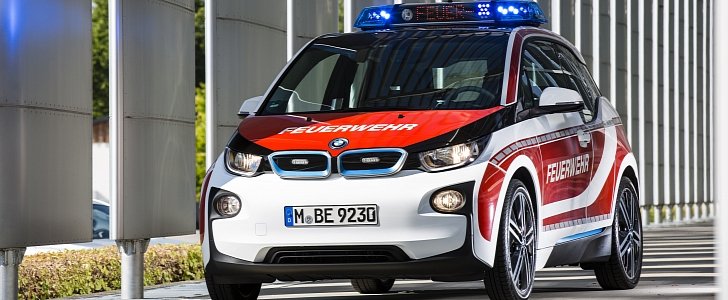BMW has been making emergency vehicles for over half a century, so you could say that it learned a thing or two over the years. All that experience is being showcased now, as the Germans have unveiled a new concept - a BMW i3 Fire Car.
We’ve seen a variety of Police Cars based on the i3 before, but nothing like this. The LAPD has one such car in its fleet, as does the police force in Munich and more recently Milan. As far as the i3 Fire Fighter goes, this is the first time we’ve seen it and we can’t say we dislike it.
As a matter of fact, the versatility of the car is impressive and was best shown when Polish Idea Bank launched a mobile ATM which was, in fact, an i3 that went around the city collecting money from those who didn't have time to visit a bank. We told you all about it a while back, and it seems like the project is still going, meaning that customers have taken a liking to it.
Of course, all these particular cars are dressed accordingly, with corresponding design foils and roof bars. An individual signaling system, front and rear flashers, as well as pressure-chamber loudspeakers, ensure that other road users are warned when the BMW i3 is on an emergency assignment. The range of equipment also includes a preliminary setup for digital radio.
The biggest advantage the i3 has over any other emergency vehicle, though, is the fact that it comes with a SIM card that allows it to tap into the ConnectedRescue system, a specially developed alternative for emergency services based on ConnectedDrive.
Using it, the crew is able to receive relevant information about the emergency (including address, reason for assignment, the contact person and their state) wirelessly, right in the car from the control center. The coordinates where they need to go can be quickly introduced into the navigation system. Furthermore, the team has the chance to prepare on the way, and traffic information helps the driver reach the site faster.
It all looks good, and the only problem we see is the fact that the 170 HP EV can only cover up to 100 miles at best (160 km), and that may not be enough considering that there’s not sufficient time to fully recharge it. Add the equipment these emergency vehicles need to operate efficiently, and that range will drop even more.
As a matter of fact, the versatility of the car is impressive and was best shown when Polish Idea Bank launched a mobile ATM which was, in fact, an i3 that went around the city collecting money from those who didn't have time to visit a bank. We told you all about it a while back, and it seems like the project is still going, meaning that customers have taken a liking to it.
Of course, all these particular cars are dressed accordingly, with corresponding design foils and roof bars. An individual signaling system, front and rear flashers, as well as pressure-chamber loudspeakers, ensure that other road users are warned when the BMW i3 is on an emergency assignment. The range of equipment also includes a preliminary setup for digital radio.
The biggest advantage the i3 has over any other emergency vehicle, though, is the fact that it comes with a SIM card that allows it to tap into the ConnectedRescue system, a specially developed alternative for emergency services based on ConnectedDrive.
Using it, the crew is able to receive relevant information about the emergency (including address, reason for assignment, the contact person and their state) wirelessly, right in the car from the control center. The coordinates where they need to go can be quickly introduced into the navigation system. Furthermore, the team has the chance to prepare on the way, and traffic information helps the driver reach the site faster.
It all looks good, and the only problem we see is the fact that the 170 HP EV can only cover up to 100 miles at best (160 km), and that may not be enough considering that there’s not sufficient time to fully recharge it. Add the equipment these emergency vehicles need to operate efficiently, and that range will drop even more.
















